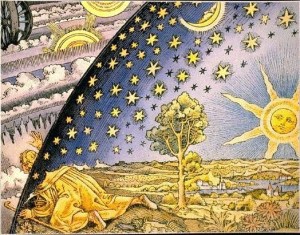
Hitler’s blitzkrieg had overrun Poland. Stewart’s wife Betty, his best friend for so many years of adventure, had died only months before. He was convinced of her survival. The sense of her presence, as intimate and unique as the scent of her hair, comforted him daily. He described the experience in detail in a last minute last chapter added to the book he’d written with her: Across the Unknown. Other friends reported visits of the same kind, sometimes accompanied by small signs, often at the mention of the name Betty, any Betty.
Of course, their friends wondered why Stewart didn’t try to reach Betty through a medium, or as he preferred to call it, a receiving station. But Stewart thought that would cheapen the profound beauty of what he was experiencing. Later he admitted to himself and to his readers that he was also afraid. What if Betty didn’t communicate? What if the communication was so obviously inferior it could put doubt into all their work together? Would he search vainly from medium to medium the rest of his life?

Betty White and Stewart Edward White
Stewart didn’t want to stay home to watch Betty’s garden of rare and exotic plants die without her despite the best care money could buy. He travelled through America two years before the attack on Pearl Harbor, having been invited to visit his many friends who wanted to console him and enjoy his company. After all, what an extraordinary life he had lived so far. He had worked in mining, lumber, ranching, then he became a popular author for decades culminating his success with a series of best sellers co-authored with Betty that became instant classics of spiritualism.From their yacht trips to Alaska to their introduction of the bird of paradise plant to Santa Barbara the Whites had been a story book marriage, a rare example of true love romping happily through the world. Teddy Roosevelt said Stewart was the best shot who ever visited his shooting range. Stewart had been a famous big game hunter, but Betty evolved him until he only hunted animals with a camera. Stewart was the kind of house guest you hope will tell stories all night long.
Throughout their experimentation with blazing a trail across the border of death, Betty’s sister in adventure was Ruth Finley. The Finleys were professional people. Ruth was a successful magazine editor, an author, historian and feminist. Emmet was a reporter, editor, and an executive in several newspaper printing and supply companies. Known as “Darby and Joan” to their readers, they were the authors of Our Unseen Guest, a bestseller in the roaring twenties.
The unseen guest was the spirit of a soldier who had died in World War One. Through a ouija board fascinating messages about matter and consciousness were given. Joan later became a voice medium. Among the many spiritualist experiments of The Whites were those when Joan and Betty were both put into trance. For an example of these experiments see Attention is Existence: Instruction of the Invisibles.
Six months passed. Then Joan had a puzzling experience in New York City. First she boarded the wrong bus. Then she indulged herself by deciding to make the mistake a happy accident by shopping in a department store she hadn’t visited for years. As soon as she entered she fixated on a cart stacked with red Chinese lacquer boxes on sale at a clearance bargain price. She had to have one, she thought, but they were sold out, she was told. She insisted on speaking to the manager and demanded they look in their stock rooms and call the warehouse. They found one for her. But instead of returning home happy with her purchase she was vexed because she already had Chinese boxes and had nowhere to put this one. All this behavior, the wrong bus, the impulse buy, was very unlike Joan who prided herself on planning her adventures, whether mystical or mundane.
Soon after all became clear when Stewart arrived to be the seen guest of Joan and Darby. They were not planning to channel Betty when Joan went into trance but Betty immediately crashed the party. She began by calling Stewart “Stewt” the name for him she only used in private. Then she provided all the proof he could want.
“Betty began,” Stewart wrote, “talking to me quietly, fluently, with assured and intimate knowledge of our common experience and living. There was no “fishing” and no fumbling. That part of it became almost ridiculous, it was so easy for her where with usual “psychical research” it has been so difficult. Here, in this first evening, she literally poured out a succession of these authentications. She mentioned not one, but dozens, of small events out of our past, of trivial facts in our mutual experience or surroundings, none of which could by any possibility be within Joan’s knowledge.”

Chinese red lacquer box circa 1939 with carved swallows
Then Betty asked Stewart to pay back Joan for the Chinese box. The box was to be sent as a parting gift from Betty to her little sister. Betty told Stewart that the important thing was the birds on the lid. Her little sister was amazed when Stewart delivered the gift. She explained that Betty and she as children would climb into a tree to watch a nest of swallows, the kind of bird carved on the Chinese box.Betty explained that all the work she had done during her life helping her learn to adapt her consciousness to the after life, the step by step ladder they had built with the help of the Invisibles, had actually been provided to give her extraordinary training in coming back to communicate with Stewart and their readers. What followed Stewart described as “forty sessions of communication with Betty; sessions vivid with her unseen presence, from turn of phrase and mode of thought to her own special brand of fun and laughter.”
With the world at war the first part of Betty’s message is that the intent of all this effort is to encourage people to find their own proof of the continuity of consciousness through life and death. She asks her readers to imagine how different the world would be if we understood we are temporary visitors with other destinations ahead of us instead of desperate creatures struggling for our brief hour in the sun. She wanted to give more than hope to families losing loved ones as the war killed millions.
Her next important message was that there are not two worlds, one for the living and one for the dead. Both worlds are the same. The difference is not in location but frequency. The frequency of the dead is not visible to the living. The world of human bodies is a much lower frequency than the intensely vital world of pure conscious energy. Consciousness is the matrix and sustenance of form. Electric current, a cloud in the sky, a bug flying by, within every variation of matter, at the heart of the particles that make forms, consciousness exists.

Betty searched through many words to find the right ones to capture the difference between these experiences of the same world. She uses a color photo versus a black and white photo of the same scene as a metaphor for how one world can be experienced two ways. The color photo, she says, provides more information. In the afterlife, outside her physical body, Betty sees much more information about the world than she did when she was living. For awhile limited versus unlimited was offered, but Betty was never comfortable with that. She finally settled on the obstructed and the unobstructed. At our low frequency our bodies which are mostly water and our world which is mostly air have an obstructive density that fills our lives with barriers.
“The obstructed universe,” Betty explains, “is for the purpose of birth, of the individualization of consciousness. All matter is born in your universe. Nothing is lost. Individuality is not lost; though in its lower forms matter can be burned, turned into gas, or what have you. Yet it is all kept. It is the highest form, the soul, that goes on undivided. Your scientists have accepted the law of the indestructibility of matter; but I say to you that this law is only a corollary of the indestructibility of consciousness.”
Betty wasn’t the only participant on the unobstructed side. Joan’s original unseen guest reappeared to lend clarification now and then. An expert on the subject under discussion would step forward to deliver a paragraph of explanation. And Anne, or Gaelic as Stewart nicknamed her, the spirit who had delivered most of Betty’s channeled material when she was among the living, has the occasional stately summation. One of them reiterates the love of nature at the heart of American Metaphysical Religion: “You must not forget that we enjoy your earth garden. There is truth in the statement that God walked in the garden in the cool of the evening. We love your earth and its beauties and grandeurs. It is very pleasing to us, and we see more of it than you, and so we love it that much more. It is a wonderful place, even in its obstructed aspects; and unobstructed, it is heaven to us who developed our quantity there.”
Searching for a vocabulary for concepts too elusive for words made inflexible by well defined connotations Betty reaches back to the language of ancient Greece. At first Joan’s subconscious mistranslates the word as eros, sparking humor on both sides. But the word Joan was looking for is more unfortunate than that. She chose orthos (ancient Greek for truth) to describe the unobstructed universe. But when most of us these days hear ortho we think of a mattress store, weed killer, braces or special shoes.
Orthos manifests itself in the obstructed universe as time, space and motion. But time, space and motion are not experienced the same way in the unobstructed part of our universe because they are only the effects of essences experienced directly in the unobstructed. We’re very near Plato’s cave here, where the world we know is made up only of the shadows of real beings we never see.
TIME

Dali’s Persistence of Time
Time receives the evolution of the acorn to the tree to the worm eaten dead wood and final ashes. Time is receptivity obstructed. We can only go one direction in time and we have to keep going. But time doesn’t work that way for Betty. It’s the difference between walking down a street between tall buildings seeing only what’s in front of you or hovering overhead with a complete vision of all the streets between all the buildings.Betty tells us that the way we control our experience of sidereal or clock time by use of what she calls psychological time gives us a glimpse of receptivity. An hour of boredom or drudgery can pass very slowly, while an hour of fun can seem to pass too quickly. She also gives the example of dreams, where a dream that seems to encompass a lifetime can occur during a short nap.
Betty explained: “All that you think and do is received and remains in time, though your physical bodies and acts vanish from space. Research, invention, material catastrophes, like earthquakes uncontrollable by your free-will, or the beneficence of a season producing big harvests–all are received in space as incidents that pass. It is in time that they remain–to condition and influence your present and the present of all coming generations. Receptivity is the essence of time.”
“The best thing I can do,” Betty said, “to make you understand our apprehension of time is to liken it to a map. It is there. We encompass it. Time, whose essence is receptivity, is experience. It is all the empirical knowledge laid out for us to use. That does not mean that it is static. The future is there too, and if we have the impulse to pick out of it some particular potential, we can do so. The future is to us much as the past is to you. You can go back in history or emotion or research or memory, and pick out any bit of empirical knowledge that you think will serve you.” This sounds like the akashic record, the complete collection of universal knowledge of every time and place mentioned by Madame Blavatsky, Edgar Cayce and many others.
SPACE
Space conducts what it contains. The space in pipes that allows water to flow, the space in our doorways and windows and inside our rooms in which we conduct our lives. A breeze in the air moving a fluffy white cloud in the sky. Space is obstructed conductivity. What appears solid to us, the obstructions that surround and define our lives, don’t exist for the unobstructed. They can move through any matter.
If psychological time gives us a glimpse at receptivity, can psychological space do the same for conductivity? Betty uses the examples of memory and imagination. While you are sitting in the space of your room, you can imagine, remember, or dream a far away place. In a sense you are in two places at once.
Betty asks us to consider the way we have been able to invent our ways around the realities of space and time. We can fly over a vast amount of space in an amount of time that in the past would have been associated with walking a short distance. The radio and the phone, the car and the train, all these inventions are steps up the ladder from space as we know it to conductivity as Betty knows it. “You can speed up or slow down, not to the same degree as ourselves, but much more than you were able to do even two decades ago. You are beginning to control the ratio of time and space–sidereal time and geographical space. Don’t you see that in thus discarding properties of the obstructed universe they are actually endowing it with the characteristics of my state of being in the unobstructed universe? They are making it as nearly unobstructed as they can!”
MOTION
Motion is obstructed frequency. The higher the frequency the shorter the wave length, and short wave lengths are more energetic. In the unobstructed Betty doesn’t travel. She simply matches her frequency to the place or person she wants to visit. This allows her to travel quickly as thought. It’s nothing you haven’t seen on DragonballZ when Goku uses his power of instant transmission.
Stewart compares this to projecting a film. If you speed the film up the characters cross space in less time. If you speed it up even faster the images will disappear into a projection of pure motion. When you slow down the film again you are adding space and time back and voila the characters, places and story reappear.
If there is psychological time and psychological space, is there also then a psychological motion that we can use to get a glimpse of Frequency? “Thought is psychological motion.” Ever have a series of illuminating thoughts in a flash only to find it takes you several hours to fully write them down or tell them to a friend? Or perhaps a depressing thought has occupied you for a time and distance one would not expect a thought to span. But frequency is much more than thought. It is the continuity of being, “habitual and persistent…the I-Am is made up of frequency.”
“Thought,” said Anne, “is an attribute of consciousness. Being an attribute of consciousness, it has frequency. It is received in time; and, according to its creative potency, it remains in time.”
This difference between clock time and psychological time, our experiences of psychological space and psychological motion are more real to us, more intimately familiar than the real world operations of our bodily organs. Reality is often a puzzling and mysterious place for us, where we are strangers in a strange land, profoundly uncomfortable. Aristotle once described the angst of soul in body as being like the Etruscan pirate torture of tying a victim face to face with a corpse. Our experience of psychological time, space and motion, our thoughts and our dreams are more comfortable to us than reality. They are glimpses of the unobstructed self shining through though veiled by matter. Your consciousness, not your beliefs or feelings, but the core of your awareness, that is the threshold of your own unobstructed self.
CONSCIOUSNESS
So what is consciousness? “The one and all-inclusive reality, in evolution. I wish,” said Betty, “that you could talk this out with some one of the bright youngsters at any of the electric research laboratories. It would mean something to him when I said that the radio beams, waves, electricity, light, all of which you are beginning to handle, are degree manifestations of only one reality; and that the highest manifestation of that reality, of which you are actually aware, is consciousness.” Here we are back at the native American reverence for a living universe where even a rock has a spirit. And so this universe of ours is the “total of all manifestations of consciousness.”
Betty uses the word arrestment to describe “an incidence of frequency, conductivity and receptivity, resulting in manifestation or individuation in the obstructed universe. Consciousness is in evolution, therefore it is in various degrees. Each degree has its frequency…the individual rate. Each degree represents a specific manifestation.” She uses the example of three slanting lines or light beams converging to intersect. “You could perhaps illustrate it by algebra. Z plus Y plus Z equals a stone. X plus 2Y plus Z equals a weed. 2X plus Y plus Z equals a flower. And so on. X is a frequency; Y is conductivity; Z is receptivity.”
What is arrestment? “Call arrestment a suspension of potentiality.” In other words, you can choose to do anything in the unobstructed, but in the obstructed you can only be what you are, when you are, where you are, like water which can flow anywhere but not when frozen into ice.
This leads to an understanding of the difference between quality and quantity of consciousness. “For purposes of evolution this universe has been divided into quantitative and qualitative aspects.”
“QUALITY OF CONSCIOUSNESS: That aspect of consciousness resulting in species manifestation, as electricity, gold, tree, antelope, man, etc. In the unobstructed universe quality is in evolution, and therefore in degrees. In the obstructed universe it is of fixed potential in its given degree.
“QUANTITY OF CONSCIOUSNESS: That aspect of consciousness, in the obstructed universe, capable of, and subject to development by the individual, in evolution and therefore in degrees.” So what we’re after in life is gaining the most quantity of consciousness that we can get with our degree of quality.
“Consciousness is the only reality,” Betty says. These concepts of the unity of the universe and the all pervasiveness of consciousness were first taught by the unseen guest in Joan and Darby’s book of the same title where one of the most important messages from the other side was “form is an attribute of consciousness.”
CREATION

William Blake’s Creation of Eve
But all these forms consciousness creates are made of something. What is matter then, this stuff of illusion? “In the obstructed universe matter is that arrestment of frequency which manifests itself in a three-dimensional extension.” Betty talks about learning the skill to cause these convergences of receptivity, conductivity, and frequency that make obstructed experiences of time, space and motion. These skills are called juxtaposition and intraposition.“JUXTAPOSITION: The manner in which frequency (motion) variably collides with receptivity (time) and conductivity (space) to result in an arrestment, producing manifestation.
“INTRAPOSITION: As juxtaposition is arrestment resulting in manifestation, so intraposition is the relationship that obtains as long as that arrestment holds.”
In other words, consciousness creates forms by juxtaposition and sustains them by intraposition. When your consciousness juxtaposed the right essences you got yourself an infant to inhabit. So long as some part of your consciousness inhabits that creation, even the apparently miniscule amount keeping someone alive in a coma, the experiment is sustained.
The Invisibles share with the great poet and artist William Blake an idea of imagination as something more profound than fantasy. The true power of imagination is creation. In the preceding book, Across the Unknown, the Invisibles said of imagination that it is “the power of juxtaposition.”
The theme of receptivity, conductivity and frequency recalls techniques the Invisibles had given them that the Whites shared in Across the Unknown. We are to enjoy a relaxed appreciation of life, to stop the flow of thoughts, perhaps with the memory of some natural beauty, to make ourselves receptive to the higher frequency, like a cup to be filled. We then become a way to conduct a higher quality of life into a world sorely needing it. Some like Betty literally channel information but everyone has their own unique contribution to make, and all such contributions depend on inspiration. What is any successful idea in any venture but some idea snatched from the invisible and made visible by labor?
UNOBSTRUCTED ANATOMY AND GEOGRAPHY
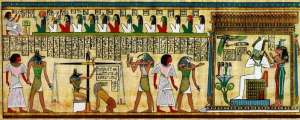 Ancient Egyptian afterlife, judging of the dead man’s heart measured against the feather of truth followed by his introduction to Osiris God of the Dead
Ancient Egyptian afterlife, judging of the dead man’s heart measured against the feather of truth followed by his introduction to Osiris God of the DeadWhat’s it like then to cross over at death? “In the first place, when you come here, one of the things that astounds you most is the lack of difference.” Your beta body is a body of light and color unique to your frequency and evolution. Your beta voice is sonorous with the music of the spheres (the ultimate auto-tune?). “Your body is not multi-cellular, not composed of numerous entities; it is integral, and expresses only your individual identity. Primary entities are indivisible. Your body, the ‘temple of the body that you–the You, the I-Am, the Being–inhabit for a period of sidereal time, is divisible; for it is made up of innumerable low degree entities of consciousness.”
Stewart wrote down what he had learned about Betty’s new life: “You are able to see and touch our world. You experience the same reactions, subjectively, as you would through your physical senses. However, you add something to what you have perceived in the flesh; you ‘see also beyond it.’ You understand us when we speak aloud to you. I gather that an unspoken message consciously addressed to you is likewise heard. I understand that you do not read thoughts not addressed you; but also you could do so if necessary or desirable. The ‘density’ so much talked about as being between your world and our world is a density affecting our receiving function. Its penetration by you is a job. But the idea that it is dulling to you, that it hampers you as a drug might, is incorrect.”
While Betty warns that it’s an oversimplification and misunderstanding to talk about brick houses and cigars on the other side, “I have my landscape. If I wish to sit beside my stream on my bank of flowers I can, by my handling of frequencies, produce an aspect of my matter that will give me a perfectly good support.” This ability to manipulate the matter of your experience brings to mind lucid dreaming, wherein the dreamer becomes conscious of the dream and can have whatever invention or adventure he or she desires.
After my gourmet uncle died I dreamed of him. He complained that the food wasn’t good in the afterlife because it wasn’t real. He just couldn’t get used to imaginary meals Does Betty miss anything about incarnation? “The only thing I miss is the use of the five senses in the obstructed universe for the expression of my love for people who are still there; and of course if I had that, I wouldn’t be here. I miss their not recognizing me, not hearing my voice, not feeling and seeing me when I’m there. And of course I am there. I miss your response. And that is all.”
Without all the obstructions of life, which take most of our time, what does Betty occupy herself with? “”Would it mean anything,” suggested Betty, “if I said we fill up the gap caused by the lifting of obstructions by means of our increased acuteness of perception. Our range of registration is so much wider.” “I think I see it,” Stewart ventured. “If you take a two-hour walk in the country with a dull person totally uninterested in nature, it seems forever; but with a naturalist, say, who knows all about the birds and pretty flowers and things, those two hours–” “That’s it!” cried Betty.”
But Betty is careful to remind us that all the these concepts merely provide glimpses. Most are metaphors, not literal descriptions.
GOOD NEWS FOR PETS

Internet memorial graphic for late pets
Most religions exclude animals from heaven since they are not supposed to have souls. Stewart wants to know what Betty has to say about that. “How about dogs? Have you got dogs in your world?” Stewart asked. “Of course I have my dogs; and I love them,” Betty replied. “Then they continue on individually as you do? As dogs, I mean.” “The individual is immortal.” But later Betty clarified: “An amoeba does not come back as an individual. It hasn’t the volitional reasoning power, and is absorbed into its degree. The amoeba has its degree here, and it has its purpose, but it does not manifest quite the same here; is not individually immortal, the way I am. For that you have to get closer to the man-degree. Dogs–my dogs are here–they do have fairly high development of volitional reasoning.”TRUE PROSPERITY
Thinking your way to prosperity is an American obsession and a recurrent theme of American Metaphysical Religion that has transformed also much of American Christianity, but Ann gives the idea a different spin: “There is a definite frequency that goes out from the minds of men of which they have not taken full cognizance, and that is thought. As a man thinketh, so is he. But I would go one step further and say: as a man thinketh, so is his surrounding habitation, so is his influence on the other frequencies he comes in contact with. Especially human frequencies. Especially those of lower degrees than his own. Nothing that happens to an individual is as important as what that individual thinks about it.”
“You go to your daily work,” Anne continues, “with a glad heart and a free mind, happy in your consciousness, and the day starts with a snap, and you affect everyone. On the other hand, you do not feel so good, and down goes the whole day; and those in contact with you get the reflex. That is a definite application of your frequency, for it’s a thing. A man can have private moods of his own, certainly–like sorrow–but this is true: that every time you overcome, you have strengthened your frequency, and you have gathered unto yourself a bit more of the source material, and the thing that is You.”
TRUE CONSEQUENCES
But what are the consequences of an un-lived life? What about those who choose to never examine the depths of thought and feeling, who do only what is convenient, or who exploit everyone they can? What of people who never develop their talents? Who ignore opportunity and discovery for a sterile and frail security? “Free will creates its own hell with the widening of the arc of understanding,” said Betty. “No person of any sensitivity at all lives in the obstructed universe without having acquired, by maturity, some regrets, either slight or deep, though generally those regrets come only momentarily, in flashes. However, they should make it perfectly possible for anyone to understand the acme of regret that is the portion of the individual coming to this place of perfect understanding who has either shirked or passed by his earth opportunities.”
TRUE PRAYER
 “You pray for us: we pray for you. You can be, in a sense, our guardian angels, as we are yours.” This is similar to the Tibetan Buddhist belief that the powa meditation can benefit the living, the dead, and even the reincarnated. But who should our prayers be directed to? “To consciousness,” replied Betty. And what is the purpose and best practice of prayer? How should we pray? “As though I were drowning in a great sea, and there was a shipful of people, any or all of whom could help me,” replied Betty promptly.”
“You pray for us: we pray for you. You can be, in a sense, our guardian angels, as we are yours.” This is similar to the Tibetan Buddhist belief that the powa meditation can benefit the living, the dead, and even the reincarnated. But who should our prayers be directed to? “To consciousness,” replied Betty. And what is the purpose and best practice of prayer? How should we pray? “As though I were drowning in a great sea, and there was a shipful of people, any or all of whom could help me,” replied Betty promptly.”DREAM YOGA
Betty offers a form of dream yoga simpler than that practiced by Tibetan Buddhists. “Frequently dreams, stripped of their emotional content, are a direct contact with the unobstructed universe and with an idea being promulgated here. With this knowledge you could become mentally adept at using your dreams, and solving your problems during sleep. And do not think for one moment that high, low and in-between do not, at times, tap the infinity of our thought.”
A MESSAGE FROM AN UNOBSTRUCTED DOCTOR
Stewart tosses in this interesting interlude near the end of the book. “This Doctor, dead these many years, and a great friend of Betty’s, spoke to us infrequently, but here is a sample of the sort of thing he had to say: “All sickness in your obstructed universe existence is nothing but a maladjustment of frequencies. All consciousness in the entire universe has a degree frequency. The individual consciousnesses of the various organs of the body each have their individual frequencies, since all consciousness has its degree-frequency. Now my point is this: In the obstructed universe I employed certain drugs, which were themselves really lower degrees of consciousness–each with its own frequency–to stimulate or retard frequency in higher degrees of consciousness as manifested in the human organism.” The good doctor goes on to suggest that future medicine will be more concerned with frequency adjustment than scalpels.
THE UNOBSTRUCTED UNIVERSE A BEST SELLER
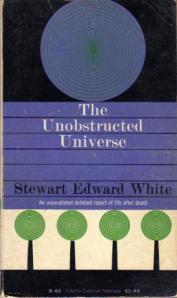
Mass market paperback of The Unobstructed Universe published in 1940
The Unobstructed Universe was Stewart’s most successful book, a bestseller and mass market paperback, into its sixteenth printing only a year after its publication. The world was engulfed in War. Paris had fallen in May. As the book hit the shelves Luftwaffe bombers began blitzing London.The last two chapters of the Unobstructed Universe are summaries. The first by Darby is a detailed restatement of the principle ideas of the book. The second by Stewart includes this poignant paragraph from Betty: “So many stepladders by which to get back,” she went on. “So many stepladders the human race has accumulated, if only it could recognize them. They are recorded in all languages and in all sorts of ways; in folk tales and the picture writings of the savage tribes; in the various bibles of the various races; in poetry, in music, in sculpture, in painting. In fact, all humanity has been reaching toward the unobstructed ever since humanity was.”
The Unobstructed Universe ends with two appendixes. The first is Stewart Edward White’s entry for Who’s Who in America 1940. He’d appeared in Who’s Who every year for four decades. When the editors intended to list Betty as deceased, they encountered the book Across the Unknown. The chapter I Bear Witness, they say particularly moved them, where Stewart describes her death and the continuing experience of her presence, and her presence to others. They decided not to change her entry. For the first time in their history a deceased VIP was listed as living. Criticism was met with the polite suggestion that judgement be withheld until after reading The Betty Book and Across the Unknown.
The second appendix is an introduction to and appreciation of The Seven Purposes by another friend of The Whites, Margaret Cameron. The Seven Purposes had been a popular metaphysical book in 1918. While the world was celebrating the end of the war to end all wars Cameron issued a warning she received by automatic writing from the spirit world that an even more terrible war was just around the corner, one that would decide the ultimate fate of humanity. “Germany…chose to follow the forces of destruction, and they will surely destroy her. But the forces she followed are uniting for a fiercer fight, more subtle, more deadly, more furious. The forces of disintegration are gathering for a tremendous fight. The Great War is one of the crises of civilization, but the battle to come still is one of the crises of eternity.”
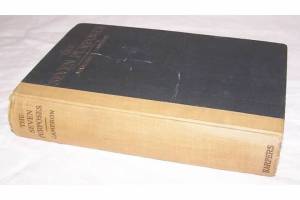
Another quote from Cameron resonates with our own times: “The forces of disintegration are wily, but fearful. Bullies and cowards. But when they are united in sufficiently strong numbers, fearless and unscrupulous. They fear the reawakening of the forces of progress in your life. This is the reason they gather now, to smite while the world is weary. Disguised as purposes of light they hope for welcome. Because men have huddled together in fear, destruction threatens them. Because free speech has been debauched to fell purpose, free men distrust it. There can be no society that will withstand disintegration that has not labor, capital, and market. When capital oppresses labor, forces of disintegration are freed. When labor dominates capital, forces of disintegration are freed. When the people forget justice, forces of disintegration are freed. And the destruction of one is the destruction of all. The rich man who denies his brother freedom is a destroyer. The poor man who denies his brother freedom is a destroyer in no less degree.”
CARL JUNG’S OPINION OF BETTY’S RETURN FROM THE DEAD
That great psychologist and student of myths Carl Jung not only read the books Betty channeled from the invisibles, he recommended them to his friends. In his forward to the German edition of The Unobstructed Universe, published in Zurich in 1948, Jung takes a skeptical stance, willing to admit the subject worthy of further attention, but as yet without solid proof. He finds great value in the Unobstructed Universe’s portrayal of the psychology of the unconscious. He suggests spirits are “exteriorized effects of unconscious complexes” then admits having observed telepathic and other psychic activity of the unconscious but insists that these phenomena provide no proof of spirits. For Jung’s own experiments with spiritualism read The Other Betty White: A True Story of Love Beyond Death.
But in a letter about The Unobstructed Universe to his friend Fritz Kunkel, Jung wrote: “Betty behaves like a real woman and not like an anima. This seems to indicate that she is herself rather than an anima figure. Perhaps, with the help of such criteria, we shall one day succeed in establishing, at least indirectly, whether it is a question of an anima (which is an archetype never lacking in masculine psychology) or of a spirit… In each individual case I must of necessity be skeptical, but in the long run I have to admit that the spirit hypothesis yields better results in practice than any other.” Jung added in the same letter: “I must own that with regard to Betty, I am hesitant to deny her reality as a spirit; that is to say I am inclined to assume that she is more probably a spirit than archetype, although she presumably represents both at the same time.”
HAMLIN GARLAND AND THE MYSTERY OF THE BURIED CROSSES
White and Garland are as close as California got to Holmes and Watson. Garland’s name appears in a footnote in The Unobstructed Universe. His book The Mystery of Buried Crosses is recommended by Stewart as proof of his experience with ghost hunting and other less intellectual aspects of psychical research. Garland was the author of over forty books, and many poems, essays and short stories, he won the Pulitzer Prize in 1922 for his book A Daughter of the Middle Border, a work of fiction with an autobiographical theme, about the hard life of pioneers in the midwest. Garland is an interesting character to whom I’ll later devote a blog. Like Stewart he was a friend of Teddy Roosevelt.Garland authored Forty Years of Psychic Research where he presented the most interesting episodes from his experiments. Although Garland admits he witnessed the inexplicable, he wondered if telepathy or some other as yet to be understood human faculty might explain such mysteries, he found no evidence that convinced him the dead survive and can communicate. His skepticism includes his opinion that if all the humans who had ever lived had all survived death where could they all be? He doubted that space held enough capacity for them all. Obviously Garland was not a believer in reincarnation.
Garland was an old man by the time Forty Years was published, he had outlived almost all of his friends. He lived in the hills of Los Feliz, I’ve been unable to find any evidence that he visited Manly P. Hall at the Philosophical Research Society, though Garland does mention lecturing at a “society” in Los Angeles. This lecture started him on the greatest psychical adventure of his life.
Garland was approached by a man who wanted to show him the spirit photographs his wife had taken. They were interesting enough that Garland called on the widower who revealed that his late wife had been an extraordinary medium. Native Californians of various tribes and the Franciscan fathers who founded the California missions, including Junipero Serra had been sending messages through her which had uncovered buried gold and money that provided just enough income for the medium and her husband to live frugal lives. But more importantly they had dug up thousands of mysterious primitive metal crosses. Neighbors had participated on these Sunday outings in search of buried treasure, and had signed affidavits that declared the medium had led them unerringly to some buried artifact always found where she said it would be.
Garland was sufficiently impressed that he promised to return when he’d completed his current book commitment. The widower pleaded with him to tell this story that he himself could never make anyone believe. Two years passed before Garland returned, but by then the widower was dead. Garland located a surviving sister who had been instructed to give the Pulitzer Prize winner all associated papers and the crosses. Garland found a huge cache of journals, notes, and attempts at writing books that had overwhelmed the poor widower. Garland inspected the crosses, eventually giving them to a local museum. He also found some of the former neighbors of the widower who had signed the affidavits (several had died by then).
The adventure that unfolded, including more buried artifacts, and a medium who channeled the late widower’s medium wife, resulted in Garland’s book The Mystery of the Buried Crosses: A Narrative of Psychic Exploration, published in 1939, in which Stewart makes a brief appearance. Garland’s skepticism had been knocked aside by a series of inexplicable experiences and he was ready to entertain the idea that life might continue after death. Skeptics dismissed him as a lonely old man seeking solace in sentimental beliefs. Neither Garland nor his fame survived World War 2. By 1956 an article was written about him in the Mason City Globe headlined “Osage Has Forgotten Author.” Sadly nowhere does Garland give us his opinion of the great experiment conducted by his friends The Whites.
This concludes our four part series on the extraordinary but almost forgotten contributions of The Whites to the history and culture of American Metaphysical Religion.
SOURCES:
The Mystery of the Buried Crosses: A Narrative of Psychic Exploration
Garland, Hamlin
E.P. Dutton
1939
Forty Years of Psychic Research
Garland, Hamlin
Macmillan
1936
The Unobstructed Universe
White, Stewart Edward
E.P. Dutton
1940
ARTICLE WRITTEN BY RONNIE PONTIAC

Newtopia staff writer RONNIE PONTIAC is a founding member and primary guitarist of Lucid Nation, executive producer of the documentaries Rap is War, Exile Nation, and the award winning animated short Cohen on the Bridge. He associate produced The Gits documentary, and was art editor, then poet in residence for Newtopia Magazine in its former incarnation . He’s a published author of works on obscure topics such as ancient Greek religion and the history of alchemy. Follow him on Twitter @AmerMysteries.





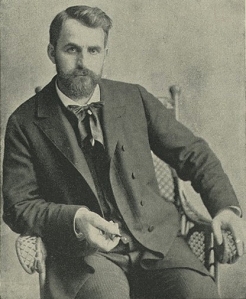
Dear Robert,
ReplyDeleteWhat a marvelous article on the Whites.
Thank you so much for printing it on your blog.
I so appreciated it.
Regards
Stephen